|
The Pentagon
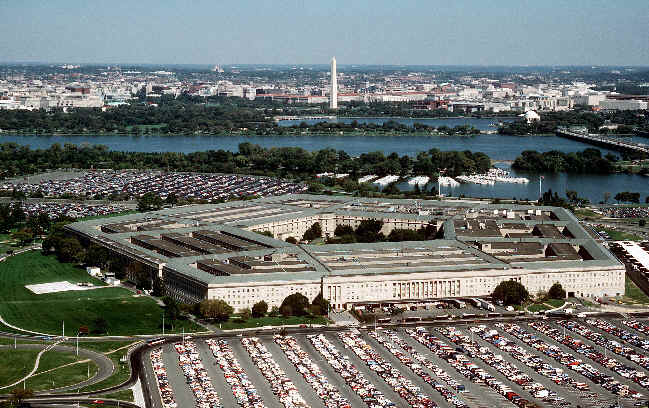
The Pentagon, headquarters of the Department of Defense, is one of the world's
largest office buildings. It is twice the size of the Merchandise Mart in
Chicago, and has three times the floor space of the Empire State Building in New
York. The National Capitol could fit into any one of the five wedge-shaped
sections.
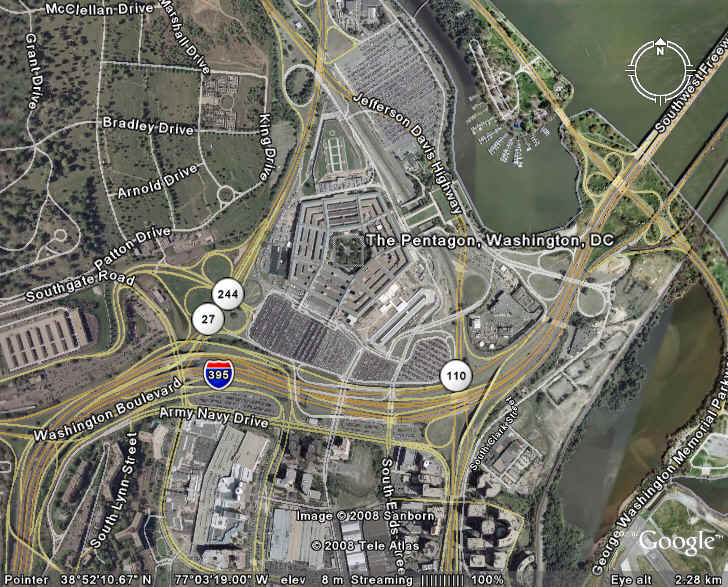
The Pentagon—a building, institution, and symbol—was conceived at the request of
Brigadier General Brehon B. Sommervell, Chief of the Construction Division of
the Office of the Quartermaster General, on a weekend in mid-July 1941. The
purpose was to provide a temporary solution to the War Department's critical
shortage of space. The groundbreaking ceremony took place on September 11, 1941.
The building was dedicated on January 15, 1943, nearly 16 months to the day
after the groundbreaking.
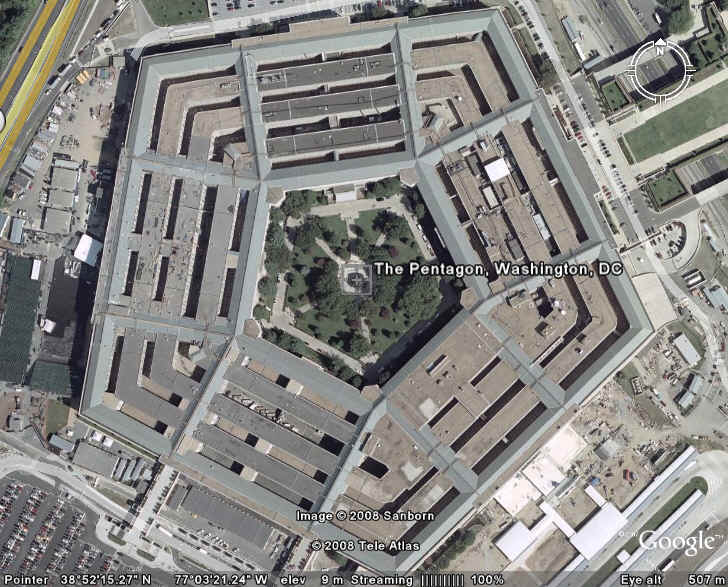
The original site chosen for the Pentagon was a tract of land known as Arlington
Farms. The site was bordered by five roadways thus dictating the concept of a
pentagonal shaped building. Fearing the enormous building would interfere with
the view of Washington, D.C. from Arlington Cemetery, President Franklin Delano
Roosevelt directed the building be moved three quarters of a mile down river.
The new location chosen was at the site of the old Hoover Airport, a brick
factory, a pickle factory, a race track, and a low-income residential area known
as Hell’s Bottom. On this site, the final design concept of an open air court
surrounded by five concentric pentagonal rings (or corridors) traversed by ten
spoke-like corridors was constructed.
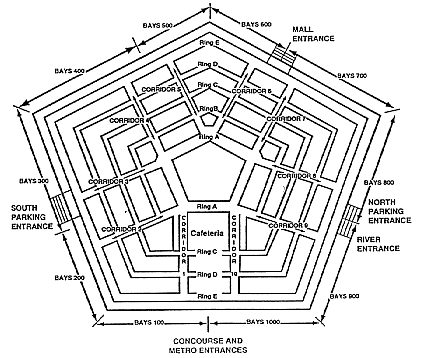
The architectural style of the Pentagon is Stripped Neo-Classical. The building
was constructed out of reinforced concrete made from 380,000 tons of sand
dredged from the Potomac River and supported by 41,492 concrete piles. The
designers’ ingenuity not only created a building that reflected the
architectural style of the nation’s Capitol but also saved enough steel to build
one battleship. At the height of construction, over 1,000 architects worked in
an adjacent hanger producing enough prints to supply the 14,000 construction
workers and tradesmen. Three shifts worked 24 hours a day, every day,
constructing the Pentagon wedge by wedge. These wedges were occupied as they
came on-line. The building was dedicated on January 15, 1943, nearly 16 months
to the day after the groundbreaking.
The Pentagon is virtually a city in itself. Approximately 23,000 employees, both
military and civilian, contribute to the planning and execution of the defense
of our country. These people arrive daily from Washington, D.C. and its suburbs
over approximately 30 miles of access highways, including express bus lanes and
one of the newest subway systems in our country. They ride past 200 acres of
lawn to park approximately 8,770 cars in 16 parking lots; climb 131 stairways or
ride 19 escalators to reach offices that occupy 3,705,793 square feet. While in
the building, they tell time by 4,200 clocks, drink from 691 water fountains,
utilize 284 rest rooms, consume 4,500 cups of coffee, 1,700 pints of milk and
6,800 soft drinks prepared or served by a restaurant staff of 230 persons and
dispensed in 1 dining room, 2 cafeterias, 6 snack bars, and an outdoor snack
bar. The restaurant service is a privately run civilian operation under contract
to the Pentagon.
Over 200,000 telephone calls are made daily through phones connected by 100,000
miles of telephone cable. The Defense Post Office handles about 1,200,000 pieces
of mail monthly. Various libraries support our personnel in research and
completion of their work. The Army Library alone provides 300,000 publications
and 1,700 periodicals in various languages.
Stripped of its occupants, furniture and various decorations, the building alone
is an extraordinary structure. Built during the early years of World War II, it
is still thought of as one of the most efficient office buildings in the world.
Despite 17.5 miles of corridors it takes only seven minutes to walk between any
two points in the building.
The original site was nothing more than wasteland, swamps and dumps. 5.5 million
cubic yards of earth, and 41,492 concrete piles contributed to the foundation of
the building. Additionally, 680,000 tons of sand and gravel, dredged from the
nearby Potomac River, were processed into 435,000 cubic yards of concrete and
molded into the Pentagon form. The building was constructed in the remarkably
short time of 16 months and completed on January 15, 1943 at an approximate cost
of $83 million. It consolidated 17 buildings of the War Department and returned
its investment within seven years.
Total Land Area (acres) 583
Government Owned (acres) 296
Purchased or Condemned (acres) 287
Total Land Cost $2,245,000
Area Covered by Pentagon Building (acres) 29 (34 including courtyard)
Area of Center Courtyard (acres) 5
Area of Heating and Refrigeration Plant (acres) 1
Area of Sewage Structures (acres) 1
Access Highways Built (miles) 30
Overpasses and Bridges Built 21
Parking Space (acres) 67
Capacity (vehicles) 8,770
Cost of Building $49,600,000
Total Cost of Project (including outside facilities) $83,000,000
Gross Floor Area (sq. ft.) 6,636,360
Net Space for Offices, Concessions and Storage (sq. ft.) 3,705,793
Cubic Contents (cu. ft.) 77,015,000
Length of Each Outer Wall (ft.) 921
Height of Building (ft.) 77' 3.5"
Number of Floors, plus Mezzanine and Basement 5
Total Length of Corridors (miles) 17.5
Building Proposed mid-July 1941
Prime Contract Awarded 11 August 1941
Mechanical Engineering Contract Awarded 3 September 1941
Construction Began 11 September 1941
Grading Contract Awarded 24 September 1941
First Occupants Move in 29 April 1942
Construction Completed 15 January 1943
Sand & Gravel Used for Concrete (tons) 680,000
Buildings Consolidated to Populate the Pentagon 17
Concept to
Early Construction (1941-1942)
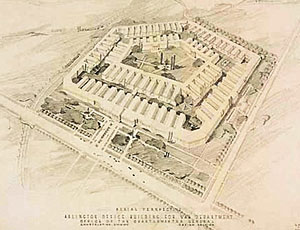
Original
Sketch for the Pentagon Building, 21 July 1941
By the summer of
1941, the War Department work force in the Washington, D.C. area numbered
more than 24,000 civilian and military personnel housed in 17 buildings and
was expected to reach 30,000 by the beginning of 1942. Providing office
space for the workers was part of the military construction mission of the
Quartermaster Corps’ Construction Division, already struggling to cope with
the vast mobilization construction underway before the United States entered
World War II.
The federal
government considered constructing temporary buildings, but Brigadier
General Brehon B. Somervell, an aggressive Engineer officer who headed the
construction division, had another idea. On Thursday, 17 July 1941, he
summoned two of his subordinates, Lieutenant Colonel Hugh J. Casey, also an
Engineer officer, and George E. Bergstrom, a prominent civilian architect,
and told them that by Monday morning he wanted basic plans and an
architectural perspective for an air-conditioned office building to house
40,000 workers in four million square feet of space, not more than four
stories high, with no elevators. Indeed, Lieutenant Colonel Casey and his
staff completed the basic layout of a five-sided building by that following
Monday, after what he later described was "a very busy weekend."
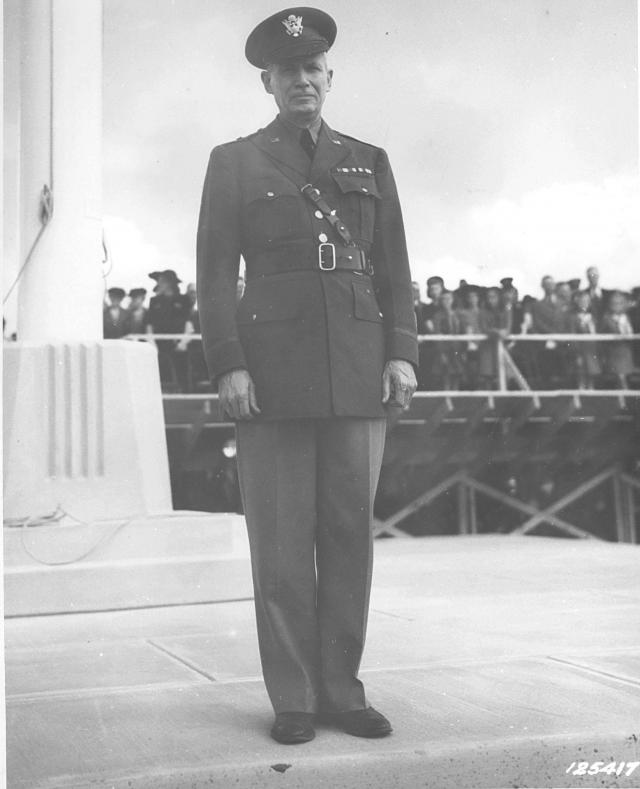
Brigadier General Brehon B. Somervell
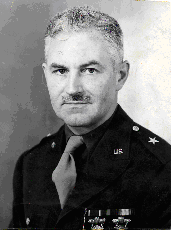
Lieutenant
Colonel Hugh J. Casey
The War
Department staff approved the building’s basic concept that Monday and the
Secretary of War approved it on Tuesday, informing President Franklin D.
Roosevelt of his plans. Also on Tuesday Somervell took the plan to Congress.
Sensitive to the severity of the space problem, Congress and the president
moved quickly to approve a supplemental defense appropriation bill,
including $35 million for the construction of the proposed War Department
headquarters.
The plans
underwent many changes in the next few months, including changes in
location. With Somervell’s approval, Casey and Bergstrom sited the building
between Arlington National Cemetery and Memorial Bridge. Some federal
agencies and local citizens did not want the proposed building to obstruct
the vista between the Lincoln Memorial and Arlington Cemetery. Appeasing
opponents, in August President Roosevelt moved the site to its current
location.
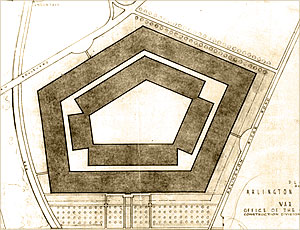
Early sketch
of pentagonal design at Arlington Farms site
Plans for the
building proceeded swiftly. Bergstrom with architect David J. Witmer developed
plans for a unique reinforced concrete building that would consist of five
concentric pentagons separated by light wells and connected by radiating
spoke-like corridors. It would have five stories and include a six-acre
interior court, numerous ramps and escalators, a large shopping concourse on
the first floor, taxi stands and bus lanes, and parking for 8,000 cars.
Construction to Completion
Construction
commenced on 11 September 1941, and continued rapidly during the winter of
1941-42. Architects for the project had little or no lead time; sometimes
construction actually outpaced planning. On 1 December 1941, when the
president signed legislation transferring the military construction mission
from the Quartermaster Corps to the Army Corps of Engineers, 4,000 men were
laboring on the building in three shifts. One section was completed by the
end of April 1942 and the first tenants moved in. The basic shell and roof
were finished in one year, and the building was completed by 15 January
1943.
The Pentagon’s
designers minimized or avoided using critical war materials whenever
possible. They substituted concrete ramps for passenger elevators and used
concrete drainpipes rather than metal. They eliminated bronze doors, copper
ornaments, and metal toilet partitions, and avoided any unnecessary
ornamentation.
The Pentagon was
the largest office building in the country at that time covering 29 acres
and housing 17.5 miles of corridors. Design and construction of such a
building would normally have taken four years, but the Corps took only 16
months. At its peak the Pentagon housed nearly 33,000 workers.
The architects
and Engineer officers who designed and constructed the Pentagon produced one
of the most innovative and unique structures of the war era. With this
massive yet efficient structure, the Corps not only resolved the problem of
housing thousands of War Department employees during the war years, they
also provided for future War Department needs.
Under the Pressure of War, the Corps Built the Pentagon in 16 Months
Credit: US Army Corps of Engineers
By the summer of 1941, the
War Department work force in the Washington, D.C. area numbered more than
24,000 civilian and military personnel housed in 17 buildings and was
expected to reach 30,000 by the beginning of 1942. Providing office space
for the workers was part of the military construction mission of the
Quartermaster Corps’ Construction Division, already struggling to cope with
the vast mobilization construction underway before the United States entered
World War II.
The federal government
considered constructing temporary buildings, but Brigadier General Brehon B.
Somervell, an aggressive Engineer officer who headed the construction
division, had another idea. On Thursday, 17 July 1941, he summoned two of
his subordinates, Lieutenant Colonel Hugh J. Casey, also an Engineer
officer, and George E. Bergstrom, a prominent civilian architect, and told
them that by Monday morning he wanted basic plans and an architectural
perspective for an air-conditioned office building to house 40,000 workers
in four million square feet of space, not more than four stories high, with
no elevators. Indeed, Lieutenant Colonel Casey and his staff completed the
basic layout of a five-sided building by that following Monday, after what
he later described was “a very busy weekend.”
The War Department staff
approved the building’s basic concept that Monday and the Secretary of War
approved it on Tuesday, informing President Franklin D. Roosevelt of his
plans. Also on Tuesday Somervell took the plan to Congress. Sensitive to the
severity of the space problem, Congress and the president moved quickly to
approve a supplemental defense appropriation bill, including $35 million for
the construction of the proposed War Department headquarters.
The plans underwent many
changes in the next few months, including changes in location. With
Somervell’s approval, Casey and Bergstrom sited the building between
Arlington National Cemetery and Memorial Bridge. Some federal agencies and
local citizens did not want the proposed building to obstruct the vista
between the Lincoln Memorial and Arlington Cemetery. Appeasing opponents, in
August President Roosevelt moved the site to its current location.
Plans for the building
proceeded swiftly. Bergstrom with architect David J. Witmer developed plans
for a unique reinforced concrete building that would consist of five
concentric pentagons separated by light wells and connected by radiating
spoke-like corridors. It would have five stories and include a six-acre
interior court, numerous ramps and escalators, a large shopping concourse on
the first floor, taxi stands and bus lanes, and parking for 8,000 cars.
Construction commenced on 11
September 1941, and continued rapidly during the winter of 1941-42.
Architects for the project had little or no lead time; sometimes
construction actually outpaced planning. On 1 December 1941, when the
president signed legislation transferring the military construction mission
from the Quartermaster Corps to the Army Corps of Engineers, 4,000 men were
laboring on the building in three shifts. One section was completed by the
end of April 1942 and the first tenants moved in. The basic shell and roof
were finished in one year, and the building was completed by 15 January
1943.
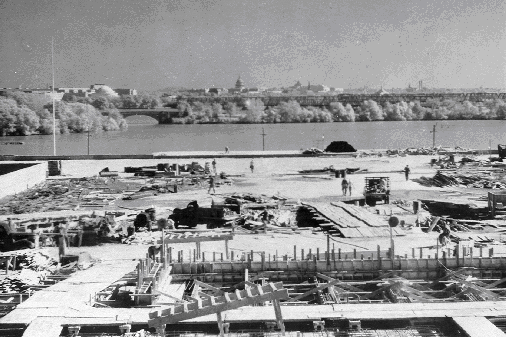
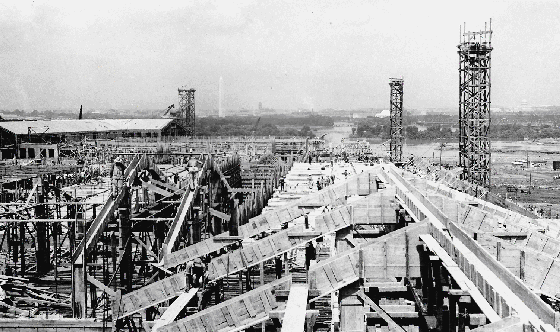
The Pentagon’s designers
minimized or avoided using critical war materials whenever possible. They
substituted concrete ramps for passenger elevators and used concrete
drainpipes rather than metal. They eliminated bronze doors, copper
ornaments, and metal toilet partitions, and avoided any unnecessary
ornamentation.
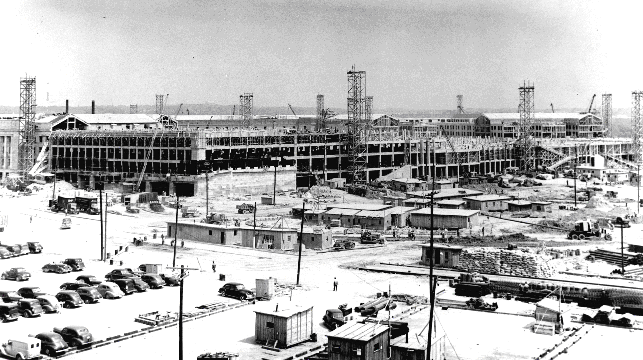
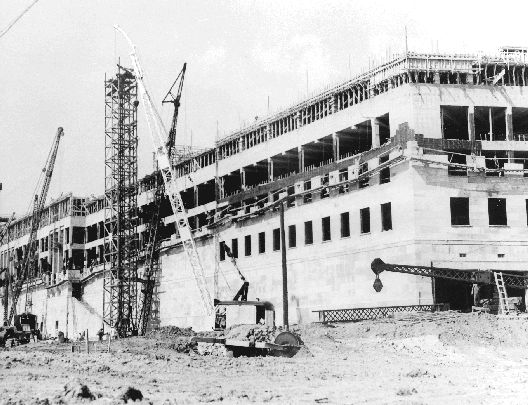
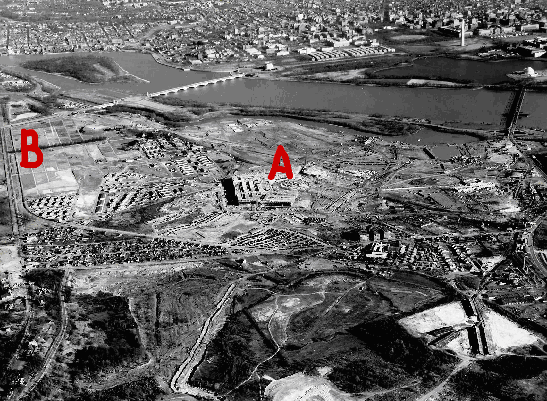
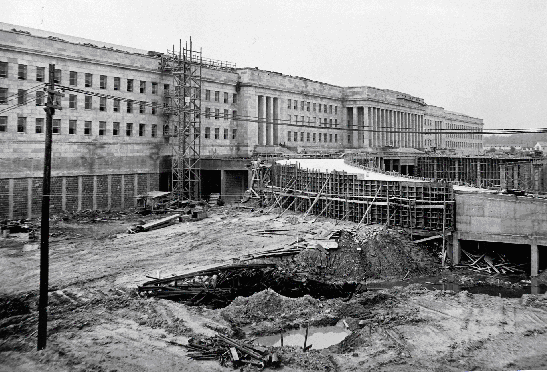
The Pentagon was the largest
office building in the country at that time, covering 29 acres and housing
17.5 miles of corridors. Design and construction of such a building would
normally have taken four years, but the Corps took only 16 months. At its
peak the Pentagon housed nearly 33,000 workers.
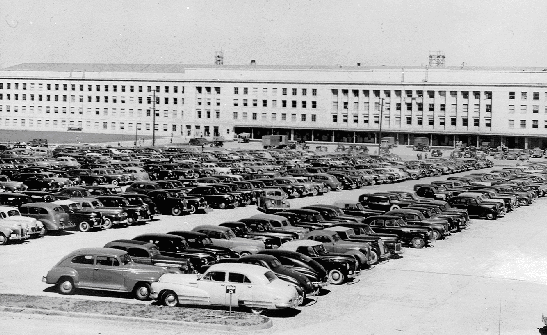
The architects and Engineer
officers who designed and constructed the Pentagon produced one of the most
innovative and unique structures of the war era. With this massive yet
efficient structure, the Corps not only resolved the problem of housing
thousands of War Department employees during the war years, they also
provided for future War Department needs.
September 11, 2001
"Freedom itself was
attacked this morning by a faceless coward and freedom will be defended...
make no mistake, we will show the world that we will pass this test."
George W. Bush
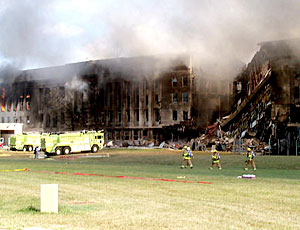
Firefighters struggle
to contain the fire, September 11, 2001
Exactly 60 years to the
day after the groundbreaking ceremony, the September 11, 2001 attacks
occurred. American Airlines Flight 77 crashed into the west side of the
Pentagon after being hijacked, killing all aboard as well as over a hundred
people within the Pentagon. The flight penetrated three of the five rings of
the Pentagon. Because the affected area was under renovation at the time,
several offices were unoccupied, sparing many lives. The aircraft struck on
the edge between two sections—one of which had just finished being upgraded.
Contractors involved in
the Pentagon Renovation Program were also charged with the task of
rebuilding the damaged section of the Pentagon following the attacks. This
additional project was named the "Phoenix Project", with the goal of having
the outermost offices in the damaged section occupied again by September 11,
2002. Part of the pre-attack renovation had involved adding improved
security features, including walls and windows with greater blast
resistance. An initial analysis suggested that the section's improvements
had saved lives, enabling more people to evacuate.
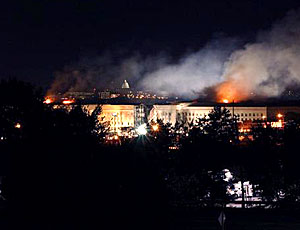
Aftermath from a
terrorist attack of the Pentagon, September 11, 2001
Repairs included
demolition of the damaged areas, complete rebuilding of the area that had
previously been renovated, and reconstruction of the shell of the
unrenovated section. The first Pentagon tenants whose offices were damaged
in the attack began moving back in on August 15, 2002, nearly a month ahead
of schedule. The repairs cost the Department of Defense about $500,000,000.
Before the September 11, 2001 attacks, an escalator ran from the Metro
station to the Pentagon lobby. After the attack this escalator was blocked
off and later removed as part of the Pentagon Renovation Program.

Credit: United States Department Of
Defense, U.S. Army Corps of Engineers
|

